Dukes of Newcastle: Family Seats
Welbeck Abbey was acquired by Sir Charles Cavendish from Gilbert, Earl of Shrewsbury in 1607, and from him, passed to his son, William [later 1st Duke of Newcastle upon Tyne]. It became the principal family seat of the early Dukes of Newcastle, who made significant additions to the house, such as the magnificent riding house built by John Smithson and commissioned by the 1st Duke. Monarchs were entertained there, as were eminent authors and poets.
Welbeck passed down through the Cavendishes into the Portland line of descent, and ultimately became the main seat of the Dukes of Portland. After the Second World War, Welbeck was leased by the Portlands to the Ministry of Defence and was used as an army training college until 2005.
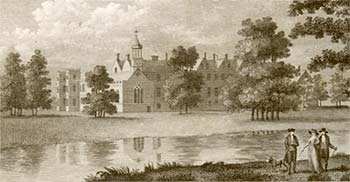
'Welbeck, Nottinghamshire', by T. Malton, published 1788
Like Welbeck, the manor and castle of Bolsover were purchased by Sir Charles Cavendish from Gilbert, Earl of Shrewsbury in 1608. Sir Charles began the process of rebuilding the castle, which was to be continued by his son, William, 1st Duke of Newcastle upon Tyne. It was William who was responsible for the building of the large indoor riding school at Bolsover and who lavishly entertained King Charles I there.
As with Welbeck, the seat passed down through the Portland line of descent, and was given to the nation by the 7th Duke of Portland in 1945. Today, it is run by English Heritage and has been the subject of extensive restoration, including the riding school.
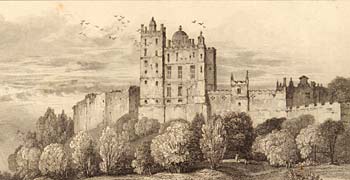
'North west view of Bolsover Castle, Derbyshire', by F. Chantrey R.A., 1823
The ruins of Nottingham Castle and its adjoining park were first acquired on lease by William Cavendish, later 1st Duke of Newcastle upon Tyne in 1641, and were purchased by him outright in 1662/3. The old medieval castle had been virtually demolished during the civil war, but William quickly set about the rebuilding process. His splendid 'ducal palace' was completed at an estimated cost of £14,000, though sadly not until 1679, after his death.
Unlike other Cavendish properties, Nottingham Castle passed into the Pelham-Holles and Pelham-Clinton lines of descent, and so continued to be associated with the title 'Duke of Newcastle'. The castle was never a permanent residence for the dukes, but was more of a town house.
In 1831, the castle was attacked and burnt by Reform Bill rioters, protesting at the anti-reform stance adopted by the 4th Duke of Newcastle under Lyne. It remained a burned out shell for the next forty years until the 6th Duke granted it to the town for the creation of a municipal gallery and museum. The restored building was reopened as such in 1878.
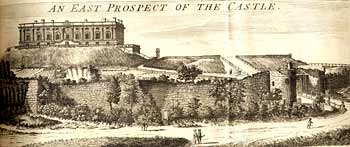
'An east prospect of the Castle', in Throsby's Thoroton's History of Nottinghamshire (1790)
Acquired at the same time as the castle, Nottingham Park had a number of incarnations during its period of Newcastle ownership, including deer park, grazing ground and favoured place for promenading. By the 19th century, the 4th and 5th Dukes of Newcastle under Lyne had begun to exploit its income generation potential, developing it as an exclusive residential estate.
The Park remained in Newcastle hands until 1939, when it was sold by the 8th Duke to the University of Oxford. Today, the Park is managed by Nottingham Park Estate Limited, which acquired the remaining rights from the University of Oxford in 1986.
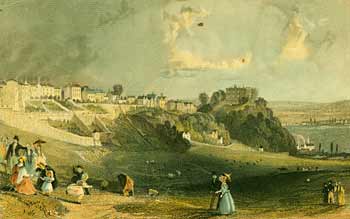
'Nottingham Park' by Thomas Allom (1804-1872) [Acc 830]
This significant estate, situated between Lincoln's Inn Fields and The Strand, London, was brought into Newcastle ownership via the Holles line of descent, having been owned by William Holles, 1st Earl of Clare. It was the subject of significant development during the 1780's when the 2nd Duke of Newcastle created a new street in the area, running from the Strand to Stanhope Street, and known as 'Newcastle Street'. Not long afterwards, the potential to generate significant income from the estate was recognised, and individual plots began to be sold off. Sales in the area were finally completed in the early 19th century, under the 4th Duke.
Claremont, near Esher, Surrey, was the favoured residence of Thomas Pelham-Holles, 1st Duke of Newcastle under Lyne. He purchased the estate in 1714, whilst still Earl of Clare, and commissioned Vanburgh to add two great wings to it. When the duke died in 1768, the property did not pass with the settled estates, but was sold by his widow to Robert Clive. Clive had the house demolished and rebuilt as a Palladian mansion by Capability Brown and Henry Holland. In 1931, the house became a private school, and is still used as such today. The gardens, however, which were famed throughout Europe, were acquired by the National Trust in 1949.
Oatlands in Surrey was granted to Arthur Herbert, Earl of Torrington by King William III. When Torrington died in 1716, he left his estates (including the Bedford Level as well as Oatlands) to Henry Clinton, 7th Earl of Lincoln. This explains the association with the Dukes of Newcastle, since the property passed from the 7th Earl to his son, Henry Pelham-Clinton, 9th Earl of Lincoln, later to become the 2nd Duke of Newcastle under Lyne. It was the 9th Earl's favoured place of residence, and he made significant additions to the mansion house, as well as laying out formal gardens and terraces. However, once the 2nd Duke inherited Clumber Park in Nottinghamshire, he made that his principal seat. The property was sold in 1788 and became the residence of H.R.H. the Duke of York and Albany. Today it is used as a country house hotel.
Clumber in Nottinghamshire was originally enclosed as a deer park by John Holles, 4th Earl of Clare and 3rd Duke of Newcastle upon Tyne, thus beginning its association with the Newcastle title. The development of the estate into a significant family seat did not take place until the later 18th century, however, when work was begun by Thomas Pelham-Holles,1st Duke of Newcastle under Lyne, to create a mansion house on the site. Though carried on in the name of the 1st Duke, much of the work was overseen by his nephew, Henry, 9th Earl of Lincoln, who would inherit his title as 2nd Duke.
The 2nd Duke continued the improvement works at Clumber, and, after selling his estate at Oatlands, Surrey in 1788, he made the house his principal place of residence. From that time, it was to remain the primary seat of the Dukes of Newcastle under Lyne until its demolition in 1938.
Originally, it was planned to build a smaller, replacement house in the park, but this work was never undertaken. Buildings remaining on the site today include the Chapel of St Mary the Virgin, built by the 7th Duke and dedicated in 1889, the muniment room and duke's study, the walled kitchen garden and a few other associated structures in the area of the lake. Clumber Park was sold to the National Trust in 1946 and remains a leading East Midlands visitor attraction.
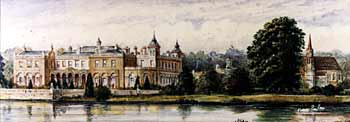
'Clumber Park'
Ranby, near Retford, Nottinghamshire, was purchased by Anna Maria Pelham-Clinton, Dowager Duchess of Newcastle under Lyne and mother of the 4th Duke in 1828. She made it her family home, shared with her new husband, Lieutenant General Sir Charles Crauford. By 1853 it was noted as being the residence of the 'Ladies Clinton', the unmarried daughters of the 4th Duke. There was consolidation of the Ranby estate under the ownership of the 5th Duke of Newcastle under Lyne, who purchased more property in the area.
The Hafod estate in Cardiganshire is associated exclusively with the 4th Duke of Newcastle under Lyne. He purchased the estate in 1835, for the sum of £62,000, selling off estates in Yorkshire in order to fund his purchase. In fact, Hafod proved to be a continual strain on the 4th Duke's resources, and he was moved to sell the estate again only 10 years later - with the exception of the celebrated library from the house, which he had moved to Clumber.
The Worksop Manor Estate in Nottinghamshire was another of the 4th Duke of Newcastle under Lyne's acquisitions. He purchased the estate from the Duke of Norfolk in 1839 at a price of £370,000 as part of his consolidation of family estates in Nottinghamshire. Newcastle ownership of the property was to last little more than 50 years, however. The manor house and surrounding parkland were sold to Sir John Robinson in 1890, and much of the remainder of the estate was also sold off, in individual lots.
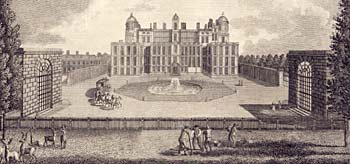
'Worksop Manor, Nottinghamshire', engraved by J. Walker, 1795
Following the demolition of Clumber in the 1930s, and the subsequent sale of the park to the National Trust in the 1950s, the 9th Duke of Newcastle under Lyne shifted the focus of the family's landholdings towards the county of Wiltshire. He purchased the former Fane estate of Boyton, which became the family's principal seat until his death in 1988.
Next page: Newcastle Family biographies